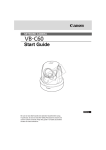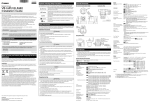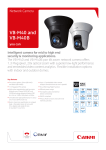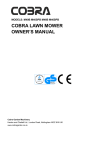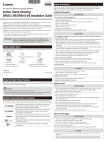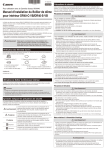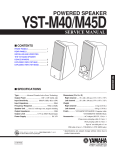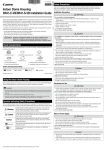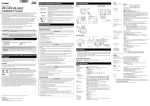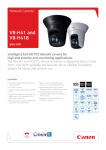Download Canon VB-M40 Installation guide
Transcript
YT1-1600-000 Request a professional installer for all camera installation work. Never try to install VB-M40 yourself. Doing so may result in unforeseen accidents such as dropping the camera or electric shock. Check Bundled Items This product comes with the following items. If any item is missing, contact the dealer where you purchased the product. 1. VB-M40/VB-M40B 4. VB-M40 Installation Guide (This document) 2. Power connector 5. Warranty card 3. Setup CD-ROM 6. Notice Write the serial number and MAC address of the camera (printed on the seal at the bottom of the camera) in the field below before storing this manual in a safe location. Serial No. MAC Address _________________________________ _________________________________ CANON INC. ©CANON INC. 2011 Printed in Taiwan Notes on Privacy and Publicity Rights Regarding the Use of Video/Audio When using the VB-M40 (for video or audio recording), it is the full responsibility of the user to protect privacy and avoid any violation of publicity rights. Canon shall have no liability whatsoever in this regard. Reference • If identifiable structures or premises will be captured, be sure to gain approval of the building management office before installing the camera. Legal Notice In some cases, camera monitoring may be prohibited by law or regulation, the details of which differ by country or region. Before using the VB-M40, check the laws or regulations of the country or region where the camera is used. Instruction Manuals • VB-M40 Installation Guide (This document) This guide provides notes on the camera installation and explains the procedures to install the camera using a ceiling mount cover (optional), as well as the main camera specifications. • VB-M40 Operation Guide (Included in the Setup CD-ROM) This document explains the initial camera settings, Admin Tools settings, viewer operations and troubleshooting, etc. Options Options can be bought separately as necessary. A ceiling mount cover or indoor dome housing is necessary to install the camera on a ceiling. Ceiling Mount Cover SS40-S-VB/SS40-B-VB This dedicated optional item is used to install the camera on a ceiling. This installation guide explains the mounting method. The ceiling mount cover is available both in silver (SS40-S-VB) and black (SS40-B-VB), to match the silver and black models of this camera. Indoor Dome Housing DR40-C-VB/DR40-S-VB This dedicated optional item lets you embed the camera into the ceiling, providing an installation with a cleaner look. The dome is available in two colors: clear (DR40-C-VB) and smoked (DR40-S-VB). AC Adapter PA-V17 A dedicated AC adapter for this camera. Caution Important Note Inappropriate handling against the instruction accompanied by this sign may result in property damage. Be sure to observe these precautions. 160 mm (6.30 in) 45 mm (1.77 in) 179 mm (7.05 in) 132 mm (5.20 in) 124 mm ( 4.88 in) * Even with the junction box plate, the height of the device is 160 mm (6.30 in) This symbol indicates important or restricted items. Be sure to read this document. Contains reference information for operation or additional explanations. Ceiling Mount Cover Safety Precautions This section explains precautions that must be observed when using the camera. If they are not observed, injury, death and/or property damage may occur. Read the following information carefully and be sure to observe the precautions. 179 mm ( 7.05 in) Installation Precautions Warning 128 mm ( 5.04 in) Do not install in the following places: • Places in strong direct sunlight, near heat-generating objects, or places subject to high temperatures • Places near fire sources or flammable solvents (alcohol, thinner, etc.) • Humid or dusty places • Places subject to lamp black or steam • Places subject to sea air • Confined or enclosed places Ceiling Plate 30.0 mm (1.18 in) • Do not install in unstable places, places subject to significant vibration or impact, or places subject to salt damage or corrosive gas, as this may result in malfunction. • The camera cannot be installed on vertical surfaces such as walls. • Be sure to attach the safety wire when installing the camera. Failure to do so may result in the camera falling or other accidents. • Do not touch the edges of metal parts with bare hands. • Do not insert your finger in the space between the parts and the ceiling. Injury may result. Caution • Do not carry the network camera by the camera head. • Do not turn the camera rotator by hand. • Do not install the camera on an unstable or inclined surface. Malfunction may result. • Take care not to damage wiring or pipes in the room. Damage to peripheral items may result. Cautions on Use Warning Image Quality Frame Rate *1 Junction box fixing holes 4.5 mm ( 0.18 in) 46.0 mm (1 13/16 in) 83.5 mm (3 9/32 in) 85.7 mm (3 3/8 in) Caution Max. Frame Rate Simultaneous Client Access Audio Compression Method Audio Communication Method Audio Playback Protocol On-Screen Display Encrypted Communications Camera Control Camera mounting holes 4- 3.4 mm (4- 0.14 in) Ceiling mount holes 4- 4.5mm (4- 0.18 in) Junction box plate holes 4- 3.4 mm (4- 0.14 in) 94.0 mm (3.70 in) 144.0 mm (5.67 in) Preset Setting View Restriction Privacy Mask Access Control Intelligent Function Event Trigger Type Image Upload Event Notification Language Notes on Power Supply Warning • • • • 1/3 type CMOS (primary color filter) Approx. 1.3 million pixels Progressive 20x Optical (4x Digital) Zoom Lens with Autofocus f=4.7 (W) – 94mm (T) F1.6 (W) – F3.5 (T) Horizontal: 55.4° (W) – 2.8° (T)/Vertical: 42.3° (W) – 2.2° (T) Auto or Manual. Auto switching between “Switching brightness” and “Response”. 0.4 lux (F1.6, Shutter Speed 1/30 sec., when Smart Shade Control is off) 0.1 lux (F1.6, Shutter Speed 1/8 sec., when Smart Shade Control is off) 0.03 lux (F1.6, Shutter Speed 1/8 sec., when Smart Shade Control is on) Night Mode (monochrome) : 0.01 lux (F1.6, Shutter Speed 1/30 sec., when Smart Shade Control is off) 0.002 lux (F1.6, Shutter Speed 1/8 sec., when Smart Shade Control is off) 0.001 lux (F1.6, Shutter Speed 1/8 sec., when Smart Shade Control is on) Focus Auto/One-shot AF/Manual/Fixed at infinity (for dome) Shooting Distance Day Mode: 0.3 m (12 in) – ∞ (W)/1.0 m (3.3 ft) – ∞ (T) (from front of lens) Night Mode: 1.0 m (3.3 ft) – ∞ (W)/1.5 m (4.9 ft) – ∞ (T) Shutter Speed 1, 1/2, 1/4, 1/8, 1/15, 1/30, 1/60, 1/100, 1/120, 1/250, 1/500, 1/1000, 1/2000, 1/4000, 1/8000 sec. Exposure Auto/Flickerless/Shutter-Priority AE, Manual (Shutter Speed/Aperture/AGC Gain) White Balance Auto/Select Light Source (Warm Fluorescent, White Fluorescent, Daylight Fluorescent, Mercury Lamp, Sodium Lamp, Halogen Lamp)/Manual/Lock (One-shot WB) * Manual setting is available with RM-Lite Metering Mode 3 options (Center-weighted/Average/Spot) Exposure Compensation 7 levels Smart Shade Control 7 levels (function for increasing the brightness of shaded subjects in an image with sharp contrast of brightness and darkness) Image Stabilizer 2 levels (Electronic) Pan Angle Range 340° (±170°) Tilt Angle Range 100º (Ceiling-mounted position: -90º – 10º) Moving Rate Pan: Max. 150º/sec, Tilt: Max. 150º/sec Video Compression Method Image Size Junction Box Plate Installing in such places may cause fire or electric shock. For installation or inspection of this camera, consult or request the dealer where you purchased the product. • This installation should be made by a qualified service person and should conform to all local codes. • When installing on a ceiling, make sure the surface is capable of withstanding the total weight of the ceiling mount cover and the camera, and is sufficiently reinforced if necessary. • Periodically check the ceiling plates and fixing screws for rust and loose material to prevent injuries and equipment damage due to falling items. Image Sensor Number of Effective Pixels Scanning Method Lens Focal Length F-number Viewing Angle Day/Night Switch Min. Subject Illumination Day Mode (color) : Server 85.7 mm (3 3/8 in) Caution To reduce a risk of fire or electric shock, do not expose this product to rain or moisture. Caution Inappropriate handling against the instruction accompanied by this sign may result in injury. Be sure to observe these precautions to ensure safety. 130 mm (5.12 in) 45 mm (1.77 in) WARNING Warning Inappropriate handling against the instruction accompanied by this sign may result in death or serious injury. Be sure to observe these warnings to ensure safety. Camera 46.0 mm (1 13/16 in) * For the latest information (firmware and bundled software, instruction manuals, operating environment, etc.) please check our website. VB-M40/VB-M40B 83.5 mm (3 9/32 in) Thank you for purchasing Canon Network Camera VB-M40/VB-M40B (hereafter referred to as the camera). The only difference between VB-M40 and VB-M40B is the exterior color. Be sure to read "Installation Guide" (this document) and "VB-M40 Operation Guide" (included in the Setup CD-ROM) before use. This "Installation Guide" explains the mounting method of the VB-M40 using the ceiling mount cover (optional). Be sure to read the "Safety Precautions" section for correct use. After reading this Installation Guide, keep it in a readily accessible location for future reference. For the installation method of this camera using the indoor dome housing (optional), please read the "DR40-C-VB/DR40-S-VB Installation Guide" bundled with the indoor dome housing. The detailed procedures for using this camera are explained in the "VB-M40 Operation Guide". Read these guides carefully before using the VB-M40 to ensure correct use. This Installation Guide uses the following marks to indicate important information the user should know in order to use the product safely. Be sure to observe these items. Main Specifications 155 mm (6.10 in) Installation Guide External Dimensions 20.0 mm (0.79 in) Network Camera Symbols Indicating Safety Precautions 66.0 mm (2.60 in) ENGLISH Only use the dedicated AC adapter PA-V17 (optional) for AC power. Do not set any heavy objects on the power cable. Do not pull, forcibly bend, scratch, or modify the power cable. Do not cover or wrap the AC adapter (optional) with cloth or blankets. Fire or electric shock may result. Be sure to read the instruction manual for the PA-V17 (optional) before use. Caution • Never touch the camera head during initialization. Initialization failure or malfunction may result. • After turning off the power, wait for at least five seconds before turning the power on again. If the power is turned on again too quickly, the camera may operate poorly. H.264, JPEG JPEG: 160 x 120, 320 x 240, 640 x 480, 1280 x 960 H.264: 320 x 240, 640 x 480, 1280 x 960 JPEG/H.264: 5 levels JPEG: 30 – 0.1 fps H.264: 30/15/10 fps Max. 30 fps (1280 x 960) *1 JPEG: Max. 30 Clients + 1 Admin Client H.264: Max. 10 Clients G.711 µ-law (64 kbps) Full-duplex (two-way) - Echo cancellation function compliant available *2 IPv4: TCP/IP, UDP, HTTP, FTP, SNMP (MIB2), SMTP (Client), DHCP (Client), DNS (Client), ARP, ICMP, POP3, NTP, SMTP authentication, WV-HTTP (from Canon), ONVIF IPv6: TCP/IP, UDP, HTTP, FTP, SMTP (Client), DNS (Client), ICMPv6, POP3, NTP, SMTP authentication, WV-HTTP (from Canon), ONVIF available SSL/TLS, IPsec (Auto Key Exchange/Manual) 3 user levels available (Administrator/Authorized user/Guest user) Up to 50 users’ user names and passwords can be set for Authorized users. Max. 20 positions. (Preset tour capable) available Number of registration: Max. 8 places, Number of mask colors: 1 (select from 9 colors) Access control (user name & password)/Host-based access control (IPv4, IPv6) <Image> Type of Detection: moving object detection, removed object detection, abandoned object detection, and camera tampering detection Field of Detection: Max. 15 places <Volume> Volume Detection External Device Input 1/2, Intelligent Function (Image), Intelligent Function (Volume), Timer FTP/HTTP/SMTP (e-mail) Temporary storage memory in camera: Max.approx 4MB, Frame Rate: Max. 10 fps HTTP/SMTP (e-mail) English/French/German/Italian/Spanish/Japanese *1) The frame rate may be reduced due to Viewer PC’s specs, the number of clients accessing at the same time, network loads, type or movement of the subject, image quality setting or other reasons. *2) A separately-sold amplifier speaker is necessary for playing audio files. “ONVIF” is trademarks of ONVIF Inc. Interface Network Terminal Audio Input Terminal (common for LINE IN & MIC IN) Audio Output Terminal (LINE OUT) External device I/O Terminal Memory Card LAN x 1 (RJ45, 100Base-TX (Auto/full-duplex/half-duplex)) Φ 3.5 mini-jack connector (monaural) LINE IN/MIC IN can be switched in the setting page. LINE IN x 1 (connect to an amplifier microphone) or MIC IN x 1 (connect to a microphone w/o amplifier) Φ 3.5 mini-jack connector (monaural) LINE OUT x 1 (connect to an amplifier speaker) Input x 2 Output x 2 SD Memory Card, SDHC Memory Card Compatible. Max. 32 GB, Frame Rate: Max. 1fps Others Operating Environment Power Supply • If you discover defective conditions such as smoke, strange sounds, heat or strange odors, immediately stop using the camera and contact your nearest dealer. Continued use may cause fire or electric shock. Power Consumption Dimensions Weight • Do not disassemble or modify the camera. • Do not damage the connecting cord. • Do not spill water or other liquid inside the camera, spray the camera with water, or otherwise make it wet. • Do not insert foreign objects into the camera. • Do not use flammable sprays near the camera. • Do not leave LAN cables, external power supplies or AC adapter (optional) power connectors connected when the camera is not in use for long periods. • Do not use flammable solvents such as alcohol, paint thinner or benzine when cleaning the camera. Installing in such places may cause fire or electric shock. AC Adapter (optional) Model Input Output Polarity Dimensions Weight Temperature: -10 – 50°C (14 – 122°F)/Humidity: 5 – 85%RH (without condensation) PoE: PoE power supply via LAN connector (IEEE802.3af compliant) AC adapter: optional PA-V17 (AC 100 V) External power source: AC 24 V/DC 12 V with PoE: Max. approx. 9.8 W/with AC adapter PA-V17: Max. approx. 12.5 W Φ 132 x 155 mm (H) (Φ 5.20 x 6.10 in (H)) (Camera only) Approx. 1150 g (2.535 lb) (Camera only) PA-V17 100 VAC 50/60 Hz 13 VDC 1.8 A (MAX), temperature -10°C to 35°C humidity 20 to 85%RH (non-condensing) When combined with the network camera 13 VDC 1.0 A (MAX), temperature -10°C to 45°C humidity 20 to 85%RH (non-condensing) Black line side (-), white line side (+) 58 mm x 118 mm x 25 mm (2.28 in x 4.65 in x 0.98 in) (W x D x H) (excluding projections) Approx. 215 g (0.474 lb) (excluding cables) Ceiling mount (optional) Model Type Network camera-mounting environments Dimensions Weight SS40-S-VB/SS40-B-VB Silver type/black type Temperature -10 to 50°C , humidity 5 to 85%RH (non-condensing) Φ 179 mm x 45 mm (7.05 in x 1.77 in) (H) Approx. 378 g (0.833 lb) (ceiling mounting bracket, ceiling mount cover) 3 Installing the Camera The following explains the procedures to install the camera on a ceiling using the ceiling mount cover SS40-S-VB/SS40-B-VB (optional). Before installing the camera, set the IP address and other network information on the camera using the "VB Initial Setting Tool". For details on how to operate the "VB Initial Setting Tool", see "VB-M40 Operation Guide". Fixing screws M3 × 4 (bundled) Recommended Power Cables for VB-M40 [Reference] Part Names Cable (AWG) Conductor size (Φ) Front LED The blue LED light comes on. • On: when powered on, during reboot, during normal use • Off: when [Off] is selected (see "VB-M40 Operation Guide", "Installation Conditions" in Chapter 4, "Setting Page") 1 Determine an installation position for the camera and drill holes in the ceiling * * When [Off] is selected, the LED light will come on for several seconds when the camera is powered on and during reboot. Use the template bundled with the ceiling mount cover (optional) to determine the positions of the fixing screw holes and wiring hole according to the camera orientation. Next, drill holes in the ceiling. SD card cover Lens Horizontal viewing angle 55.4°, 20x optical zoom, AF zoom lens 2 Attach the ceiling plate to the camera Fix the ceiling plate to the camera with the four screws (M3) bundled with the ceiling mount cover (optional). 6 4 Camera head Safety wire attachment When installing the camera on a ceiling using the optional ceiling mount cover or indoor dome housing, attach the safety wire that comes with the optional product. Serial No. The camera's serial number. Write the number on the back of this Installation Guide before installing the camera. Connecting the Camera Note Important The camera can be installed in the upright position. Attach commercial anti-slip guards to the base of the camera and set on a flat, stable surface without inclination, or fix the camera to a tripod, etc. Be sure to use a tripod with mounting screws shorter than 5.5 mm (0.22 in). Using a tripod with mounting screws 5.5 mm (0.22 in) or longer may damage the camera. Also, use a tripod with a base diameter of 30 mm (1.18 in) or more. Using an SD Memory Card Place your fingers on the left and right holds of the SD card cover and pull to remove. To return the SD card cover to the camera, use the same procedure in reverse. Removing the card Push the SD memory card in all the way until the card slightly pops out. Pinch the card and remove. Important • Make sure the SD memory card isn't write-protected. • When using an SD memory card with the camera for the first time, it is recommended that you format the card after inserting it into to the camera (see "Memory Cards" in Chapter 4, "Setting Page" in the "VB-M40 Operation Guide"). • Insert the SD memory card before installing the camera. Note • The camera does not have a power switch. Connecting and disconnecting the LAN cable (PoE power supply), AC adapter, or external power supply plug turns the power ON and OFF, respectively. • When the camera needs to be rebooted, perform the reboot operation from the camera setting page (see "Maintenance" in Chapter 4, "Setting Page," of the "VB-M40 Operation Guide"). Important • When connecting sensors and switches, connect terminals that are electrically isolated from the respective power and GND. • Do not push the external device I/O terminal button with too much force. Doing so may cause the button to remain pushed-in. J External Device Output Terminals (OUT1, OUT2) External device output terminals consist of two sets (OUT1, OUT2) of two terminals. The sets have no polarity. Controls from the viewer can be used to switch between continuity and insulation between the terminals. Using optical couplers, the output terminals are isolated from the camera's internal circuit. The load connected to the output terminals should be within the following rating range. Rating between output : maximum voltage 50 VDC Internal Connection Diagram terminals Continuous load current at or +3.3 V below 100 mA Note Adaptive wiring for external device cables Solid conductor AWG: No. 28 - 22 Conductor size: Φ 0.32 - 0.65 mm (0.013 - 0.026 in) Cable strip should be approx. 8 - 9 mm (0.315 - 0.354 in) 10 kΩ 10 kΩ 1 kΩ + External device Output terminal IN1, IN2 0.1 µF External device Output terminal OUT1, OUT2 Audio Input/Output Terminals J PoE (Power over Ethernet) Each audio input/output terminal has one input system and one output system. Connecting the camera to an audio input/output device such as a microphone or a speaker with an amplifier allows you send/receive audio through the viewer. Important • Check with your Canon sales representative for more information about PoE HUB and Midspan technology. • Some PoE HUBs allow current limits for each port, but applying limits may interfere with performance. If using this type of PoE HUB, do not limit the operating current. • Some PoE HUBs have total consumption current limits for ports, which can interfere with performance when multiple ports are in use. For more information, check the instruction guide for your PoE HUB. • Use a category 5 or higher cable 100 m (328 ft.) or less in length for the LAN cable that connects the camera and the PoE HUB. • When the camera is connected to a switching HUB, changing the connection while the camera is operating may cause the HUB learning function to interfere with communication. Do not change the connection when the camera is operating. • The camera can also be connected to an AC adapter (optional) while receiving power from a PoE HUB. In such cases, the PoE power supply is given priority, and the camera does not use the power supply from the AC adapter (optional). When the PoE power supply is disconnected, power is supplied automatically from the AC adapter (optional). Midspan (a LAN cable power supply device) is a device that, like a PoE HUB, supplies power to the camera via a LAN cable. J External Power Supply Push the SD memory card as far as possible into the SD card slot. Use the dedicated PA-V17 AC adapter (optional). Power can be supplied to the camera in the three ways described as follows. SD card slot Inserting the card J AC Adapter Power Connection The camera supports PoE functions. Power can be supplied to the camera by using a LAN cable to connect it to a PoE HUB that conforms to the IEEE 802.3af standard. The camera position is initiated (see "Maintenance" in Chapter 4, "Setting Page" of the "VB-M40 Operation Guide"). 64 m (210.0 ft.) Use UL cable (UL-1015 or equivalent) for 12-VDC or 24-VAC wiring. External device I/O terminals consist of two sets (IN1, IN2) of two terminals, with the negative terminal connected to the camera interior GND. Connecting cables to the positive and negative terminals and creating electrical continuity or insulation between the terminals notifies the viewer. The camera's unique address. Write the address on the back of this Installation Guide before installing the camera. Align the (O) mark on the ceiling mount cover with the (I) mark on the rear of the camera, and turn the cover clockwise to the (I) position. Check that the ceiling mount cover is securely attached. Fixing screw (bundled) x 4 32 m (105.0 ft.) 46 m (151.0 ft.) J External Device Input Terminals (IN1, IN2) MAC address 7 Reboot the camera when the installation is complete 23 m (75.4 ft.) 29 m ( 95.1ft.) External Device I/O Terminals Used for the ceiling plate with the optional ceiling mount cover or the ceiling bracket for optional indoor dome housing. 6 Install the ceiling mount cover Ceiling Plate 14 m (45.9 ft.) 18 m (59.0 ft.) Screw holes for ceiling mounting If an AC adapter PA-V17 (optional) or external power supply is used, connect the power connector to the camera. Connect cables to external device I/O terminals and audio input/output terminals as necessary. Fixing screw (bundled) x 4 9 m (29.5 ft.) 11 m (36.1 ft.) Audio input terminal (dual LINE IN and MIC IN) Fixing screw hole for tripod 5 Connect the LAN cable to the camera through the wiring hole Junction box plate 5 m (16.4 ft.) 24 VAC maximum cable length External device I/O terminals consist of two input and output systems each. VB-M40 Viewer and RM Viewer can be used to check external device input status and control ouput to an external device (see "Operating the External Device Output" and "Displaying Event Status" in the "VB-M40 Operation Guide"). Bottom Cutout section 12 VDC maximum cable length External Device I/O Terminals Turn on the power while pushing this switch using a sharp object. Continue to push the switch for 5 seconds or more to restore all factory settings except for the date and time. Fix the ceiling plate to the ceiling at four points using the appropriate screws. The ceiling plate has four diameter Φ 4.5 screw holes. Use the appropriate screws for ceiling mounting in accordance with the condition and material of the installation site. If the cables cannot be stored above a ceiling made of concrete, etc., or if the cables do not fit within the ceiling mount cover, bend the cutout section of the ceiling mount cover using diagonal pliers, etc., to create a cutout through which to guide the cables. #16 (1.30 mm) (0.051 in) Reset Switch If a wiring hole cannot be opened in a concrete ceiling, etc., secure the wiring to a comparable location. Use the junction box plate (bundled with the ceiling mount cover (optional)) to mount the camera to the junction box. 1 Attach the junction box plate to the junction box with screws that match the screw holes in the junction box. 2 Mount the ceiling plate to the camera using the four bundled fixing screws (M3). 3 Attach the ceiling plate to the junction box plate using four bundled fixing screws (M3). 4 Turn the ceiling mount cover over the ceiling plate to fix it in place. #18 (1.03 mm) (0.041 in) 100Base-TX support PoE power supply (IEEE802.3af standard-compliant) Audio output terminal (LINE OUT) Important Attaching to a Junction Box #20 (0.82 mm) (0.032 in) 100BT LAN connector Power connection terminal Securely attach the safety wire to an anchor or structure. After securing one end of the safety wire to the ceiling, secure the other end to the camera using the screw that is fastened to the camera. 7 #22 (0.65 mm) (0.026 in) Rear 3 Secure the safety wire 4 Fix the ceiling plate to the ceiling #24 (0.52 mm) (0.020 in) Internal controller 2 12-VDC or 24-VAC input can be used. Connect the bundled power connector as shown below. Screwdriver Tightening torque: 0.2 N·m (1.77lbf·in) (max) For 12-VDC and 24-VAC input, use a power supply insulated from 100 VAC. 12-VDC can be connected in a non-polar configuration. Strip Important Approx. 4 to 6 mm (0.16 to 0.24 in) Power connector (bundled) • The power supply should be within the following voltage range. • 24 VAC: Voltage fluctuation within 10% of 24 VAC (50 Hz or 60 Hz ± 0.5 Hz or less) Current supply capacity of at least 1.0 A per camera • 12 VDC: Voltage fluctuation within 10% of 12 VDC Current supply capacity of at least 1.5 A per camera • When using a 12-VDC battery power supply, be sure to connect resistors of at least 0.5 - 1.0 Ω/20 W in series to the power line. • For an external power supply, use a double-insulated device. J Audio Input Dual LINE IN/MIC IN (monaural input) Although the camera has a single audio input system, it supports two types of microphone inputs: LINE IN and MIC IN. Before using the audio input, change the input mode on the Setting Page (see "Audio Input Mode" in the "VB-M40 Operation Guide"). LINE IN is selected by default. Input terminal: Φ 3.5 mm (Φ 0.14 in) mini jack (monaural) • Dynamic MIC IN Input impedence: 1.75 kΩ ± 20% * Supported microphones: Output impedence: 400 Ω to 600 Ω • Condenser MIC IN Input impedence (microphone bias resistance): 2.2 kΩ ± 20% Microphone power supply: plug-in power (voltage: 1.8 V) * Supported microphones: Condenser microphones with plug-in power support • LINE IN Input level: up to 1 Vp-p * Use a microphone with an amplifier. J Audio Output Terminal LINE OUT (monaural output) Connect the camera to a speaker with an amplifier. Audio can be sent to the speaker from RM Viewer. Output terminal: Φ 3.5 mm (Φ 0.14 in) mini jack (monaural) Output level: up to 1 Vp-p * Use a speaker with an amplifier. Important • According to microphone specifications, switch the LINE IN/MIC IN settings on the Setting Page before use (see "Audio Input Mode" in the "VB-M40 Operation Guide"). Using a wrong input may damage the camera and/or microphone. Be sure to configure settings correctly. • Microphone characteristics may affect volume and sound quality. • Use RM Viewer to send audio to the speaker. VB-M40 Viewer cannot be used to send audio. • Images and audio do not always synchronize properly. • Audio may be interrupted depending on PC characteristics and network environment. • Images and audio can be distributed to up to 30 clients. However, audio may be interrupted when distributing to many clients. • Audio may be interrupted when using antivirus software. • Connecting and disconnecting the LAN cable interrupts the audio. Use the viewer to reconnect.


